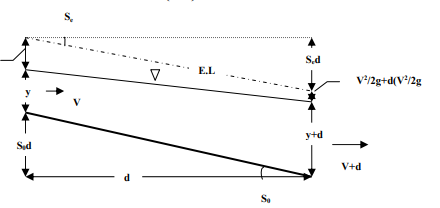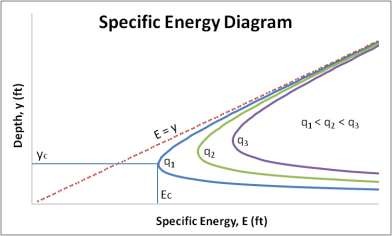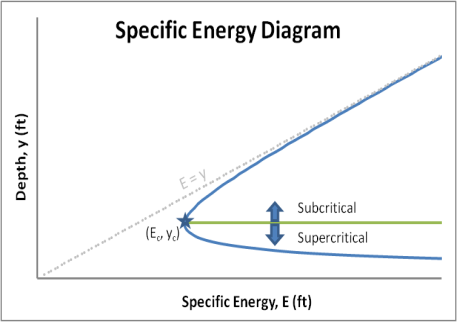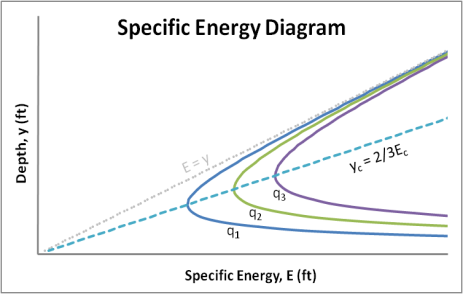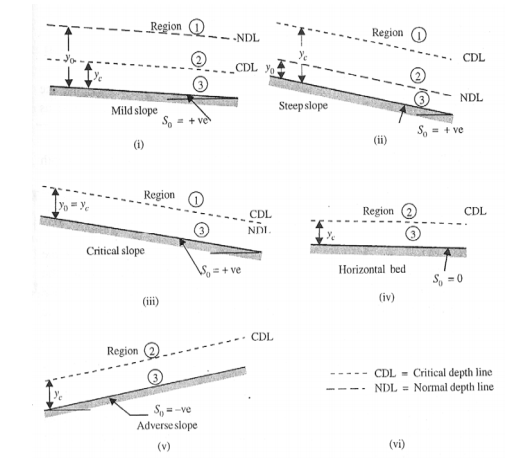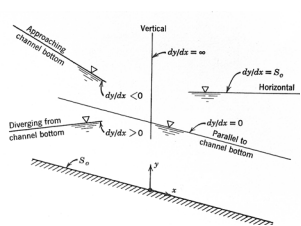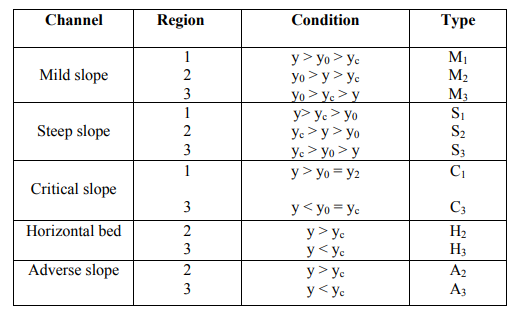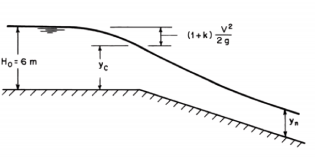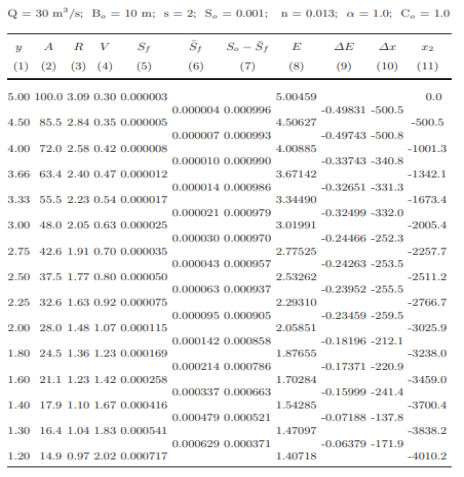|
|
|
The kinetic energy, in feet, is represented as the velocity head,
|
|
|
and the total specific energy at any point in the system is,
|
|
A4) The critical depth value mentioned in the E–y diagram section above is mathematically represented by the ratio of the fluid velocity to the velocity of a small amplitude gravity wave. This ratio is called the Froude number.
|
|
|
A5) Using the conjugate depth equation and the duality concept between the dimensionless forms of the momentum (M') and specific energy (E") functions an analytical relationship between alternate depths can be obtained.
1) Start with the conjugate depth equation
|
 then the resulting M-y relationship will be numerically identical to the dimensionless M'-y' relationship since yc is unity. For this unit discharge q, the Froude number simplifies to:
then the resulting M-y relationship will be numerically identical to the dimensionless M'-y' relationship since yc is unity. For this unit discharge q, the Froude number simplifies to:
|
|
|
|
 = q/y
= q/y and recognizing that Fr2= (yc/y)3= q2/gy3, the final analytical alternative depth relationship can also be represented as:
and recognizing that Fr2= (yc/y)3= q2/gy3, the final analytical alternative depth relationship can also be represented as:
|
|
For a channel section of any other shape, the resultant pressure may be taken at the centroid of the flow area, at a depth, z, from the surface. Then the momentum formulation is: |
|
|
|
|
|
|
And also,
1. As y → y0, V →V0, Se = S0
The water surface approaches the normal depth asymptotically 2. As y → yc, Fr 2 =1, 1 − Fr2 = 0,
3. As y → ∞ , V= 0→ Fr = 0→ Se→0
|
|
For critical flow, unit discharge,
|
Or
|
|
|
|
 Column 6, Sfˉ This is the average of Sf for the current depth and the previous depth. This column is left blank for the first line since there is no previous depth when we start the computations. To indicate that this is an average slope, we list it between the lines corresponding to the current and the previous depths. Column 7, So − Sf¯ This is obtained by subtracting the Sf¯ of column 6 from the specified value of S0. Column 8, E The specific energy, E, is computed for the selected value of y of column 1 and the corresponding computed value of V of column 4, i.e., E = y + αV2/(2g). Column 9, ΔE = E2 − E1 This column is obtained by subtracting E for the current depth from E for the previous depth. Again, since this column is the difference of E values corresponding to the current and the previous depths, we list its value between the lines for these depths. Column 10, Δx = x2 − x1 The distance increment is computed from the equation, Δx = (E2−E1)/(S0− Sf¯), i.e., dividing column 9 by column 7. Column 11, x2 This is the distance where depth y will occur. It is obtained by algebraically adding Δx of column 10 to the x2 value for the previous depth.
Column 6, Sfˉ This is the average of Sf for the current depth and the previous depth. This column is left blank for the first line since there is no previous depth when we start the computations. To indicate that this is an average slope, we list it between the lines corresponding to the current and the previous depths. Column 7, So − Sf¯ This is obtained by subtracting the Sf¯ of column 6 from the specified value of S0. Column 8, E The specific energy, E, is computed for the selected value of y of column 1 and the corresponding computed value of V of column 4, i.e., E = y + αV2/(2g). Column 9, ΔE = E2 − E1 This column is obtained by subtracting E for the current depth from E for the previous depth. Again, since this column is the difference of E values corresponding to the current and the previous depths, we list its value between the lines for these depths. Column 10, Δx = x2 − x1 The distance increment is computed from the equation, Δx = (E2−E1)/(S0− Sf¯), i.e., dividing column 9 by column 7. Column 11, x2 This is the distance where depth y will occur. It is obtained by algebraically adding Δx of column 10 to the x2 value for the previous depth.
|
𝑏 = 3 m 𝑄 = 12 m3/s (a) Discharge per unit width: 𝑞 = 𝑄/𝑏 = 12/3 = 4 m2/s Then, for a rectangular channel:
Answer: critical depth = 1.18 m. (b) For a rectangular channel,
Answer: minimum specific energy = 1.77 m. (c) As 𝐸 > 𝐸𝑐 , there are two possible depths for a given specific energy. 𝐸 ≡ ℎ + 𝑉2/2g where 𝑉 = 𝑄/𝐴 = 𝑞/ℎ (for a rectangular channel) Substituting values in meter-second units:
For the subcritical (slow, deep) solution, the first term, associated with potential energy, dominates, so rearrange as
Iteration (from, e.g., ℎ =4) gives ℎ = 3.948 m. For the supercritical (fast, shallow) solution, the second term, associated with kinetic energy, dominates, so rearrange as:
Iteration (from, e.g., ℎ = 0) gives ℎ = 0.4814 m. Answer: alternate depths are 3.95 m and 0.481 m.
|

